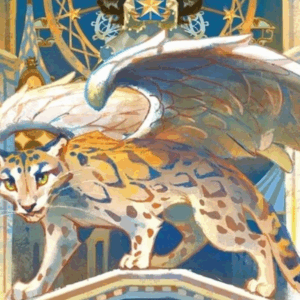
Emilie Menzel on Depicting Animals in Poetry, Learning from Music, and Constructing a New Self
Diana Khoi Nguyen in Conversation with the Author of “The Girl Who Became a Rabbit”
In this intricate debut, The Girl Who Became a Rabbit (Hub City Press), Emilie Menzel assembles a new poetics of prose, a modern mythology of moments intimate, haunting, and quotidian. Its twining rhizomatic sections document the history and toll of having a body, of surviving, of loss. Here the poet turned haruspex is equipped with a lyric that is part scalpel that (joins instead of rends) and part bryologist’s loupe, gazing upon a cow’s eye, okapi, dik dik, snow leopard, owl, piglet, and other creatures.
At its core, Rabbit is also a fabular primer on how to construct a self, from the reality of one’s body to its imagined forms, transformations, and possibilities. “Let the imagined body be more important than real,” Menzel writes, and in the spaces of a body and its multitudes, they instruct us how to witness through radical acts of observation.
I’ve never read anything quite so spell-binding, frank, and voracious in its generous curiosity.
–Diana Khoi Nguyen
*
Diana Khoi Nguyen: I’d like to start with part of the epigraph to your lyrically lush and feral collection—the quote is from Jennifer S. Cheng: “To build a house: one is for shelter, / the other to unfold….”
I’m drawn to “unfold” as a kind of shadow-side to the notion of home and shelter, also the words “fold” and “unfold” recur throughout your collection. In another interview, you write that your work is not autobiographical, but “a fabled rendition—the silhouettes, iconography, sounds, settings of my experiences, but recombined and bent. Like if the memory were folded, or one corner pulled wide.”
Tracking the various folds and unfoldings in your work brings to mind a material practice; I know you’re a gatherer. Will you kindly speak more to your relationship to (un)folding?
Emilie Menzel: Jennifer S. Cheng’s books House A and Moon: Letters, Maps, Poems were enormously influential to me at the start of writing Rabbit—my orientation to narratives of a body, how myths can be domestic and quotidian, how recursion can be an act of honesty. Both of these books anchor stories about home with the folktale The Lady of the Moon, and the folktale itself became remarkably resonant for me in thinking about how transformation is framed in myths.
I wanted to move through Cheng’s proposition that a home—the body a home—becomes a home when you build it, and that building anew (or refolding) may first require an act of deconstruction.
In the story, Chang’e, the wife of the Sun archer, drinks an elixir intended for her husband that makes her immortal, incurring the wrath of the gods who then trap her within the moon. There’s many renditions of the story varying whether Chang’e drinks the elixir because she is escaping her husband or because she is greedy for freedom, and that duality is a large interest of Cheng’s writing. In both books, Cheng pushes back against having one tidy conclusion and considers how Chang’e’s lunar transformation could be both out of necessity and an ecstasy.
I was drawn to this story of transformation caused by rupture or necessity, then embodied and owned. The delight of being lunar or of being allowed creatureliness and unruliness! The body unfolded by another but then releasing and unfurling and refolding and again moving with play. I wanted to move through Cheng’s proposition that a home—the body a home—becomes a home when you build it, and that building anew (or refolding) may first require an act of deconstruction.
I want to clarify that the fabric of this book is my personal experience. It is that fabric that is folded and unfolded, as in an unfolding and opening of light, unfolding to open a window and let in the sea. Folding and unfolding as in searching, gathering, quilting. Like a fabric, a turning over cloth desperately to locate the spot, if it is still there.
In Rabbit, there is an interest and need for truth seeking through these foldings. I found the folding-unfolding movement to allow space—in interpretation for the reader to engage with what was held in the searching, but also space for me as a writer to allow this story.
Rabbit was very much built in armfuls, knit, rearranged, shifted in vignettes, then the vignettes reordered, reopened, folded together, unfolded. Like an origami deer where you have to crease, then reopen the lines of the body preemptively in order to effectively fold a new form.
DKN: I’m now thinking of those moments in childhood: the act of folding accordion paper fans, and the braiding of paper into a slender accordion that becomes a cat’s tail for classroom Halloween decor.
Your response touches upon other significant motifs in the book: form and deer ( animals, creatures). The title refers to a transformation of girl into rabbit, and there are numerous animals in the (at times snowy) woodlands of the fabular lyric.
Can you talk a little bit about metamorphosis? There’s the hiding of the body, a wishing of the body to be something else, and meditations on animal forms (selkie, etc.) and animal behavior. In my own work, I often turn to animal behavior and find distanced ways of understanding peculiar human behavior.
On a formal level, your work resists form through its use of prose–there’s no visual takeaway; one must begin reading in order to unlock the world intricately assembled. The lyrical prose (its recursions, repetitions, and new green sprouts) feel also like a transmuting of lived experience into something distilled, timeless, timely. Please talk to me about about transformation.
EM: In your mention of the book’s title, I think again of folding and creases. I’ve somewhat coyly presented the premise of the book as a pivot: Girl, then Rabbit, became as the inflection point.
But the metamorphosis is purposefully less tidy, and, again, it is more the promise of a movement between forms that is the transfigural element rather than any settled animal or figure. The Girl Who Became the Menagerie, and they all spill out.
You note the selkies, and their shedding and redonning of skins is a particularly apt description of the philosophy of metamorphosis in the collection. The selkie is not human, not animal; she is also the water and the current and the fear of discovery, the delight of removing a conceit.
In terms of form as prose versus lineation, your description of the writing having no “visual takeaway” is an interesting phrase: the needing to move through the poem to understand the poem. I played with fabular and fairy tale rhetoric in part as a prompt to just begin, jump in without wading through premise.
I found that as soon as I placed the writing into a prose shape, readers brought an assumption of narrative. They brought their own propulsion or prompt, nudges forward.
But there is not necessarily a clean entry point into the book’s lyric sensory current, and there’s absolutely an intersection here of metamorphosis as movement and the form of the book’s construction through adjacent vignettes and sections, the premise of these as parts to build a single poem.
On animals and animal behavior as transfiguration: I come from a family of animal behavioralists, and in many ways learned to watch and relate to people through a naturalist animal behavior lens. I was taught to value a highly careful, precise, particular form of observation for understanding all behavior. I learned to orient my observations around the cares and motivations of the animal, to be wary of the desired observations I carried myself and pressed upon the experience.
The animals feel familiar. The animal feels like home. The starting point of connection feels important in Rabbit; are you beginning with trust of the animal or trust of the human? In Rabbit, the transfigurations are into the animal, which is in many ways a coming home. The body must be transfigured into animal in order to be viewed with care.
DKN: To orient one’s observations around “cares and motivations of the animal,” and to be mindful of what one might bring to the encounter of observing and witnessing feels akin to an empathetic way of noticing which becomes a way of being. And I’m thinking of empathy as the “put yourself in someone else’s shoes” advice we’re told as children.
“The animal feels like home” is startling in its truthfulness. The home sought in the collection isn’t a familial domicile, but a familiar place, one culled from time spent deeply observing other entities (nonhuman and human).
You’ve mentioned drawing the same rabbit doodle a hundred times as a way to get better at drawing, and I’m fascinated by this practice, which feels tedious, frustrating, and also enlightening. I can’t wait to try this myself. In attempting to capture something that many times, in inviting failure and pushing through failure, what unexpected moments arise in the drawing of a rabbit, or renewed attempt at a poem (or moment in a poem)?
In Rabbit, the transfigurations are into the animal, which is in many ways a coming home. The body must be transfigured into animal in order to be viewed with care.
EM: Tedious indeed! But the goal was perhaps more an acceptance of messiness than one of a masterful rabbit. The drawings improved slightly, but not significantly. They are still, after a hundred rabbits, a collection of messy rabbits. And so the parallel to the poem.
The collection grew from my acceptance of repetition, from a belief that many poetic accruements can build a new poem. I had to allow and accept the messiness. When I wrote in lineated form, I removed the repetition, and the writing became overly formal, flat, lacking movement. When I began writing in prose, I committed to taking up space on the page, in my language, in the luxury and importance and necessity of being indirect.
In prose, I kept the repetition and found a poetics in documenting the searching for the next word. To return to observation, I had to both allow an empathetic gaze and remove the precision of observation in order to gather language.
In the hundred rabbit drawings, I think about attention to detail. About the fixation of practicing the same gesture of ears or fur or thigh, with such a high level of magnification.
How to build a home for the rabbits, a poetic momentum, when you are building it grass blade by grass blade? The rabbit had to run. I think, too, of cubist artwork where the portrait is painted from ten simultaneous angles. It’s the belief that many glances, moments of observation, can together paint a scene that cannot be told head on.
DKN: The simultaneity of angles is resonating deeply; I hadn’t thought to consider recursion through a Cubist lens!
I’d like to pivot to the auditory realm. In the collection, there’s mention of violin, of piano, and I read that you “used to be a pretty active pianist and violinist” and “pull on that developed instinct for timing when breaking stanzas.” Beyond timing, breaks, and silence, how has your violin and piano training and practice informed your compositional practice?
EM: As a violinist, there’s a rather particular way you twist your body and arms. As a classically trained violinist, you are trained to pay acute attention to your posture, to the minute angles of your fingers and hands. As a pianist, I was taught how to pay attention to the length of muscle down my back and how to lean that back muscle in order to gather the weight of my arm and hand. I used to love to play piano in the dark, barefoot.
As a musician, I was taught a way of relating to my physicality and that my physicality translated minutely into voice and sound. Slight angles mattered. Your approach to the notes and phrases mattered. It was from a musician’s perspective that I began considering how we are explicitly taught to relate to our physical forms, and what could happen if that narration was reimagined.
It was from a musician’s perspective that I began considering how we are explicitly taught to relate to our physical forms, and what could happen if that narration was reimagined.
DKN: Barefoot playing piano in the dark feels like the precise mood for your collection. I’m thinking about what I read recently about horses and their riders: one telltale sign of an experienced rider is the way in which the horse becomes an extension of the rider, rather, the two become one moving entity. The horse will begin to move in the direction from the rider merely having a thought of that direction–without any physical indication of where the rider wants to go.
I’m probably romanticizing what I read, but I love this idea of each angle of the body–that all the muscles, including the smallest ones do affect our relationship with what that body touches.
EM: This makes me think about musicianship and horseback riding as in some ways akin to transfiguration, too! The extension of the self into a new form. It’s interesting to me that you describe the interconnected musculature as romantic. As a violinist, I found that to be such a large responsibility. To be responsible for all your gestures of thoughts! If only.
______________________________

The Girl Who Became a Rabbit by Emilie Menzel is available via Hub City Press. Read an excerpt of Menzel’s book-length poem here.
Diana Khoi Nguyen
Diana Khoi Nguyen is a multimedia artist and award-winning poet whose work has appeared in journals such as Poetry, American Poetry Review, Boston Review, PEN America, and The Iowa Review, among others. She recently won the 92Y's Discovery / Boston Review 2017 Poetry Contest and the Omnidawn Open Book Contest. She has also received awards, scholarships, and fellowships from the Academy of American Poets, Key West Literary Seminars, Bread Loaf Writers Conference, Provincetown Fine Arts Work Center, Community of Writers at Squaw Valley, and Bucknell University. She is currently a doctoral candidate in Creative Writing at the University of Denver, and teaches at the Lighthouse Writers Workshop and the Daniels College of Business at the University of Denver. Her collection, Ghost Of is available from Omnidawn Publishing.












